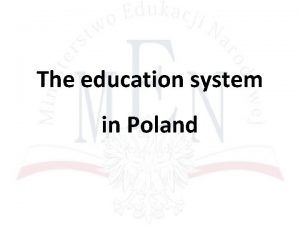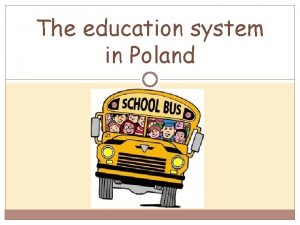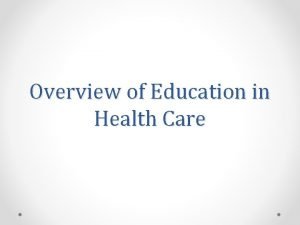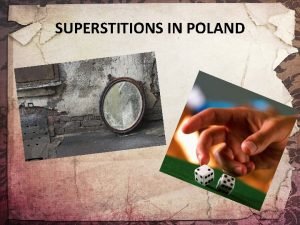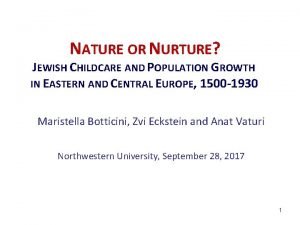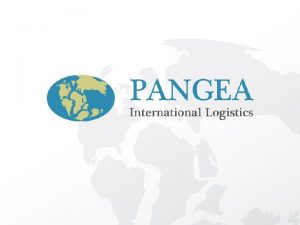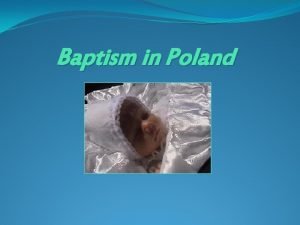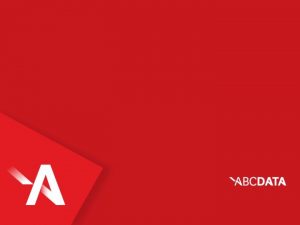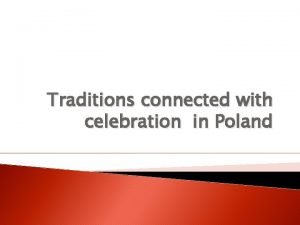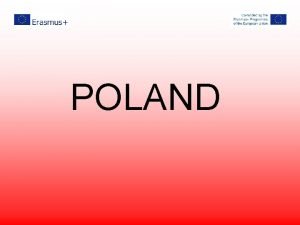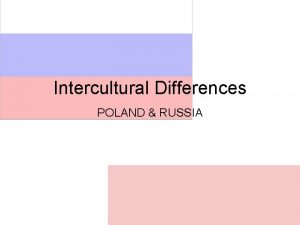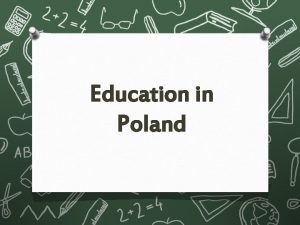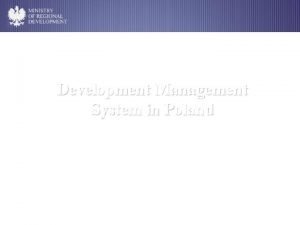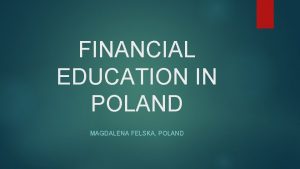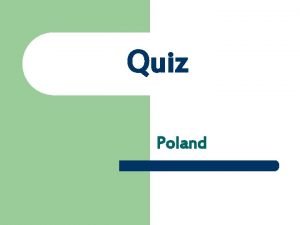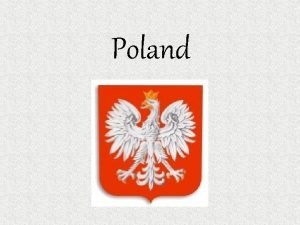The education system in Poland Overview The education



















- Slides: 19

The education system in Poland

Overview The education system in Poland is centrally managed by the Ministry of National Education and the Ministry of Science and Higher Education. Fulltime compulsory education (to be received in school) covers children and young people aged 6 -16 years, whereas part-time compulsory education (to be received in school or non-school settings) concerns young people aged 1618 years. Compulsory education includes the final year of pre-primary education, 6 -year primary education and 3 -year lower secondary education. Nursery schools (przedszkole), primary schools (szkoła podstawowa) and lower secondary schools (gimnazjum) are administered by commune (gmina) authorities. Upper secondary schools, which are not compulsory, are attended by the vast majority of the population in the age group 16 -19/20 years and are administered by district (powiat) authorities. Autonomous higher education institutions offer mainly first-, second- and third-cycle programmes (long-cycle Master's degree programmes are available only in a few fields of study). Adult education is provided by continuing education centres, practical training centres and further and in-service training centres.

Structure of the national education system

Early childhood education and care 1. Structure and organization Early childhood education and care (ECEC) is divided in Poland into two stages: for children aged 0 -3 years in creches and, as from 2011, kids clubs, or settings where care is provided by day child carers and nannies; and for children aged 3 -6 years in nursery schools (przedszkole), pre-school classes in primary schools (szkoła podstawowa) and other preschool settings, including pre-school units and centres.


Pursuant to an amendment to the 1991 School Education Act which came into force on 1 September 2009, the age of entry into primary education will be gradually lowered from 7 to 6 years. During the following school years, 2009/10, 2010/11 2011/12, 2012/13 and 2013/14 decisions to enroll 6 -year old children in the primary school are taken by parents and school heads. Six-year olds may be admitted to the primary school on condition that the school offers suitable facilities and the child has completed one year of pre-school education or that his/her school readiness has been confirmed by counseling services.

In the school year 2012/2013, 73. 5% of the 3 to 6 year-olds population participated in pre-school education. The proportion of children attending pre-school institutions is still larger in cities and towns (86. 9%) than in rural areas (only 55. 6%). Five and six-year olds represent the overwhelming majority of children attending preschool institutions as they are required to complete one pre-school preparatory year in a nursery school or pre-school classes in a primary school. Despite the fact that children may now enter primary education at the age of 6, as many as 77. 6% of 6 -year olds still attend pre-school institutions.

Primary education is accessible to, and obligatory for, all pupils (covering 99% of the population). Children are required to enter primary education when they have reached or will reach the age of 7 in a given school year. As from 1 September 2014, an obligation for 6 -year olds to start fulltime compulsory education will be introduced. In 2014 this obligation will concern children born in the first half of the year, i. e. children born before the end of June 2008. The introduction of this obligation will be spread over two years: (a) in 2014 it will concern children born from January till the end of June 2008 and all children born in 2007; (b) in 2015 - children born from July till the end of December 2008 and all children born in 2009.

- At present, in the transition period, i. e. from 2009 to 2013, all six-year old children who attended pre-primary schools can be admitted to the primary school without the necessity to obtain a positive opinion of the psychological and educational support centre. - Primary education covers 6 years. - Public primary education is free of charge for all pupils. - All non-public primary schools are required to obtain the public school status. - Primary education ends with an external compulsory test. - General education in the primary school is divided into two stages: • Stage I, including grades I to III of the primary school and covering early school education, • Stage II, including grades IV to VI of the primary school.

Secondary and Post-Secondary Non-Tertiary Education The following types of secondary schools exist in Poland: I. Lower secondary school • a 3 -year lower secondary school (gimnazjum) leading to a final exam which gives access to upper secondary education. II. Upper secondary schools, including: • a 3 -year basic vocational school (zasadnicza szkoła zawodowa); graduates receive a diploma confirming vocational qualifications upon passing a vocational exam and may continue education in grade 2 of general upper secondary school for adults ; • a 3 -year general upper secondary school (liceum ogólnokształcące) where students may obtain a matriculation certificate (świadectwo maturalne) upon passing the matriculation exam (egzamin maturalny); • a 4 -year technical upper secondary school (technikum) where students may obtain a diploma confirming vocational qualifications upon passing of a vocational exam, and may also take the matriculation exam (egzamin maturalny) and obtain a matriculation certificate (świadectwo maturalne); • a 3 -year special school preparing for employment which are intended for pupils with moderate and severe mental disabilities and pupils with multiple disabilities, and which award a diploma confirming preparation for employment. III. Post-secondary schools • a post-secondary school (szkoła policealna) for those who have completed secondary education, which offers programmes lasting up to 2. 5 years and awards diplomas confirming vocational qualifications to those who have passed a vocational examination.

Higher Education Higher education currently includes the following types of programmes: • college programmes (ISCED 5 B), provided by public and non-public teacher training colleges (kolegium nauczycielskie), foreign language teacher training colleges (nauczycielskie kolegium języków obcych) and colleges of social work (kolegium pracowników służb społecznych), which last 3 years and are classified as tertiary education for international comparisons, but are not recognised as higher education in the national legislation ; • degree programmes (ISCED 5 A), provided by both public and non-public university-type higher education institutions (uczelnia akademicka) and non-university higher education institutions (uczelnia zawodowa), which comply with relevant requirements; these include: – first-cycle programmes which last 3 to 4 years and lead to a Bachelor's degree (licencjat or inżynier, depending on the field of study); programmes lasting 3 to 4 years lead to a licencjat degree, and those lasting 3. 5 to 4 years lead to an inżynier degree; – second-cycle programmes which last 1. 5 to 2 years and lead to a Master's degree (magister or an equivalent degree, depending on the field of study); – long-cycle programmes which last between 4. 5 and 6 years and lead to the same Master's degree (magister) or the same equivalent degree as second-cycle programmes; however, no new long-cycle programmes may be launched in most of the existing fields of study as of the academic year 2007/08; – third-cycle or doctoral programmes (ISCED 6) which last 3 to 4 years and are provided by: (1) units of university-type higher education institutions authorised to confer either the post-doctoral academic degree of doktor habilitowany or the academic degree of doktor in at least two different disciplines of a given area of science; and (2) research institutions other than higher education institutions (units of the Polish Academy of Sciences and research and development institutions) authorised to confer the post-doctoral academic degree of doktor habilitowany. Moreover, both teaching and research institutions offer non-degree postgraduate programmes (ISCED 5 A), open to holders of a Bachelor's or Master's degree, which last 1 to 2 years. However, these programmes are considered a part of continuing or adult education.

College programmes (ISCED 5 B) offered in all three types of colleges prepare students for employment. Teacher training colleges (kolegium nauczycielskie) train teachers for nursery schools, primary schools and education-and-care establishments. Foreign language teacher training colleges (nauczycielskie kolegium języków obcych) train teachers of foreign languages for all levels of school education – from pre-primary to upper secondary schools and other institutions providing education or training below the higher education level. Both types of colleges may also be authorised to provide courses leading to a teaching qualification (a socalled pedagogical qualification), which is required to practise the teaching profession, and in-service teacher training courses. Colleges of social work (kolegium pracowników służb społecznych) train prospective social workers, and may also offer in-service training courses in the areas of welfare and social work.

First-, second- and long-cycle programmes (ISCED 5 A) are provided by both university-type HEIs (uczelnia akademicka) and non-university HEIs (uczelnia zawodowa). First-cycle programmes aim to provide knowledge and skills in a specific area of study, preparing students for work in a specific profession. Graduates of first-cycle programmes have access to second-cycle programmes. Second-cycle and long-cycle programmes aim to provide specialist knowledge in a specific area of study, preparing students for creative work in a specific profession. The completion of both second-cycle and long-cycle programmes provides access to third-cycle (doctoral) programmes.

Third-cycle (doctoral) programmes Doctoral (third-cycle) programmes (ISCED 6), which are offered by university-type HEIs (uczelnia akademicka) and research institutions, aim to provide advanced knowledge in a specific area or discipline of science, preparing students for independent research and creative activity and for the award of a doctoral degree (doktor). Thus, they facilitate the preparation of an applicant for the procedure leading to the award of a doctoral degree. However, the completion of a doctoral programme is not a precondition for the award of this degree. Doctoral degree holders may continue their research career to obtain first a post-doctoral degree (doktor habilitowany) and subsequently a professorial title (profesor).


Academic calendar The academic year in Poland is divided into two semesters of 15 weeks each – the winter and the summer semester. The winter semester starts in October and ends in mid-February, with a break of about ten days for the Christmas holidays. The examination session usually takes two or three weeks, beginning in January. The summer semester starts in mid. February and ends in June, with a one-week break for Easter. Summer holidays last for three months from the beginning of July to the end of September, but only for those students who passed all exams within the summer examination session (two-three weeks in June). Those who failed take the exams again in September.

Examinations & grading • • • All higher education institutions are required to end their courses with examinations. There may be several independent examinations or tests in separate parts of a subject. Usually, oral and written examinations are held at the end of each semester during the examination session. Students sit examinations on each subject separately. The performance assessment period covers either one semester or one academic year. To successfully complete a semester (or a year), a student must attain a pass mark (at least “satisfactory”) for all assessments and examinations in the subjects covered by the curriculum and obtain performance assessment credits for all integrated placements. Grading: Each HEI identifies its grading scale in its Study Rules. The most common scale comprises the following marks: 5 very good (bardzo dobry) 4 good (dobry) 3 satisfactory (dostateczny) 2 unsatisfactory/fail (niedostateczny) credit/pass (zaliczenie) Sometimes the plus symbol or decimal is used to modify the numerical grades. It must be pointed out at this time that grades awarded according to the scale are not directly transferable to the ECTS credits.

Diploma In order to graduate, students are required to: • pass a performance assessment for all subjects, integrated placements and practical work sessions, and pass all examinations covered by the study programme set for a given field of study; • present, at an appointed date, a diploma project and attain a pass mark for that project; • pass the diploma examination. Upon graduation, a student receives a diploma of completion of studies in a specific field of study together with a Diploma Supplement (copy of the diploma describing the degree, level and specialisation).

Further information https: //webgate. ec. europa. eu/fpfis/mwikis/eurydice/index. php/Poland: Over view (you can also use the „Topics” bookmark) http: //www. go-poland. pl/higher-education-institutions http: //eacea. ec. europa. eu/education/eurydice/index_en. php http: //www. go-poland. pl/5 -reasons-study-poland
 Academic year in poland
Academic year in poland Education system in poland presentation
Education system in poland presentation Overview of education in health care
Overview of education in health care Polish national symbols
Polish national symbols Omg welder
Omg welder March march dabrowski
March march dabrowski Superstitions in poland
Superstitions in poland Composite decking poland
Composite decking poland Full dress
Full dress Poland population 1939
Poland population 1939 Poland is located in which country
Poland is located in which country Freight forwarder in poland
Freight forwarder in poland Epnm poland
Epnm poland Easter in poland
Easter in poland Eabassoc
Eabassoc Eastern european cuisine history
Eastern european cuisine history Baptism of piland
Baptism of piland Abc data s.a.
Abc data s.a. How does poland celebrate the epiphany
How does poland celebrate the epiphany Swedwood zbąszynek
Swedwood zbąszynek
